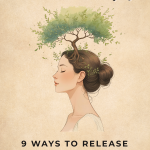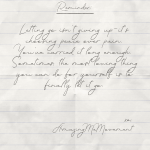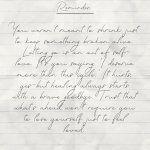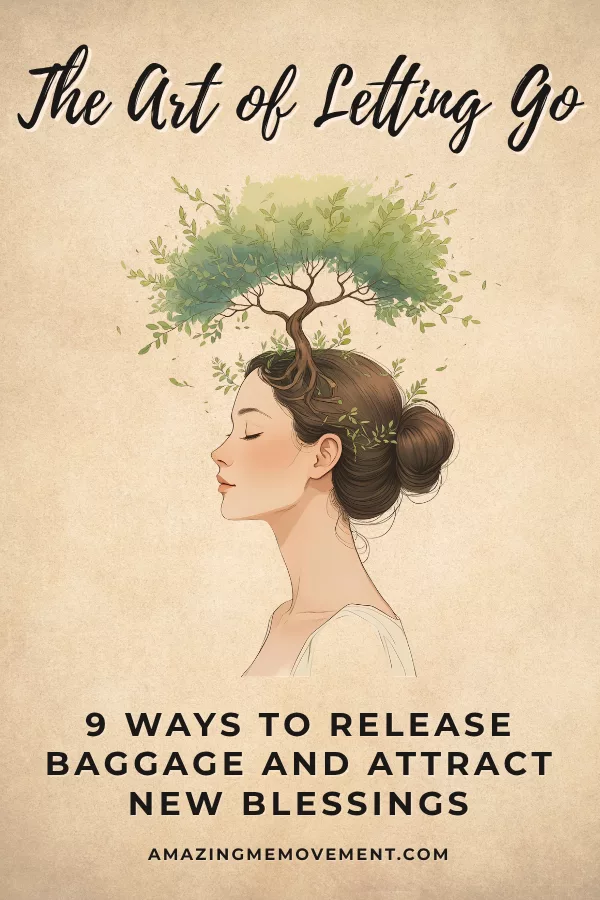Holding on to pain, regret, and unnecessary weight is exhausting. Whether it’s the job that drains you, a friendship that’s run its course, or guilt that keeps replaying in your head like a broken record, carrying emotional baggage dims your light. But here’s the good news: letting go isn’t giving up; it’s giving yourself a fresh start.
In this post, we’ll dive deep into the art of letting go; what it really means, how to release the things that are holding you back, and how to start making space for new blessings to enter your life. Ready to release what no longer serves you? Let’s go.
Why Is It Important to Learn the Art of Letting Go?
Sometimes, we don’t even realize how much we’re holding on to until life starts to feel… heavy. Not just emotionally, but spiritually, energetically, and even physically. We carry old wounds like armor.
Regrets, missed chances, heartbreaks, or people who changed on us—they quietly build up until there’s barely any room left inside us for anything new.
That’s why the art of letting go is more than just a trendy phrase or a cute quote. It’s a sacred decision to clear out what no longer serves your soul—so you can finally breathe, finally grow.
Letting go doesn’t mean forgetting what happened. It means choosing yourself over the weight. It’s the moment you decide to stop clinging to closed doors so you can start unlocking better ones.
When you allow yourself to release baggage, you’re not just moving on—you’re clearing space.
Space for peace. For healthier relationships. For creativity, joy, and opportunities that align with the healed, wiser version of you.
And that’s when the magic kicks in: you begin to attract new blessings.
Brighter beginnings. Deeper connections. The kind of abundance you’ve been quietly hoping for. Because when your hands are no longer full of what’s breaking you, you can finally hold what’s meant to build you.
Master The Art of Letting Go: 9 Ways To Release Baggage
Acknowledge What’s Holding You Back
Before we can let go of anything, we have to recognize that it’s there. Emotional baggage, limiting beliefs, toxic relationships—whatever it is, it lives rent-free in your head until you call it out.
Ignoring your pain or pretending it doesn’t affect you only gives it more power. Facing it is the first courageous step toward healing.
It’s not weakness—it’s self-awareness. When you bring the baggage to light, you reclaim control over it.
The Art Of Saying No: Reclaim Freedom By Setting Boundaries
For example:
- Journal about recurring negative thoughts or emotional triggers that keep coming up in your daily life.
- Make a list of people or habits that leave you drained or feeling small.
- Reflect on patterns (like self-sabotage or procrastination) that may stem from unresolved pain or fear.
Accept What You Cannot Change
Sometimes, the hardest thing about the art of letting go is the desire to rewrite the past. You keep playing the “what if” game in your mind, wishing you said this or did that differently. But obsessing over what you can’t control traps you in an emotional loop. Acceptance doesn’t mean you’re okay with what happened—it means you’re choosing peace over paralysis.
For example:
- Say out loud: “This happened. I can’t change it, but I can choose how I move forward.”
- Stop replaying old conversations in your head; when they pop up, redirect your thoughts toward what you’re grateful for now.
- Practice mindfulness through deep breathing or meditation to anchor yourself in the present.
Forgive (Even If You Don’t Forget)
Forgiveness isn’t about excusing hurtful behavior or pretending everything’s okay. It’s about setting yourself free. Holding onto resentment, bitterness, or anger poisons you, not the other person.
Forgiveness is a gift you give yourself… it cuts the emotional cord and clears space for better things to enter.
For example:
- Write a forgiveness letter (you don’t have to send it) to someone who hurt you, expressing how you felt and what you’re releasing.
- Say, “I forgive you, not for your sake—but for mine,” as a personal mantra.
- Forgive yourself for past mistakes by affirming: “I did the best I could with what I knew then.”
Create New Mental Habits
Your mindset shapes your reality. If your inner voice is always tearing you down or anticipating the worst, you’re unintentionally attracting negativity.
The art of letting go means rewiring your brain to speak life into your situation, even when it feels hard.
New blessings can’t grow in toxic soil.
Your mind is the garden so make sure to weed it.
10 Hidden Signs of Emotional Fatigue You Might Be Ignoring
For example:
- Replace “I can’t do this” with “I’m learning as I go, and that’s okay.”
- Start each morning by repeating 3 positive affirmations about who you are becoming.
- Follow creators, podcasts, or books that uplift you and challenge your perspective.
Declutter Your Physical Space
Your environment affects your energy. Clutter, both visual and emotional, creates mental chaos.
When you clear out what you no longer need, you’re symbolically telling the universe, “I’m ready to receive something new.” Letting go physically can jumpstart the emotional letting go too.
For example:
- Clean out your closet and donate clothes that no longer reflect who you are or who you’re becoming.
- Organize your phone: unfollow toxic accounts, delete unused apps, clear old photos that make you sad.
- Light a candle or burn sage after decluttering to reset the vibe in your space.
Set Boundaries (And Mean It)
Boundaries aren’t walls, they’re gates. They protect your peace, time, and energy.
Without boundaries, you’re saying yes to everyone else and no to yourself.
Letting go of guilt around saying “no” is life-changing. The people meant for you will understand. The ones who don’t? Let them walk.
Which Strategy Can Help You Strengthen Your Resilience?
For example:
- Say, “I’m not available right now, but I’ll get back to you when I can,” instead of overcommitting.
- Mute or limit contact with people who constantly drain your energy or cross the line.
- Create non-negotiable time blocks in your schedule for rest, self-care, or creative pursuits.
Stop Over-Explaining Yourself
You don’t owe anyone a full essay on why you’re choosing peace. Letting go of the need to be understood by everyone is part of reclaiming your power.
Not everyone will get your healing journey… and they don’t have to.
Your growth doesn’t need permission.
For example:
- Instead of long texts explaining your boundaries, keep it simple: “I’m focusing on my peace right now.”
- Decline invites or plans without guilt: “Thanks for thinking of me, but I’ll pass this time.”
- Resist the urge to defend every choice you make; silence can be a strong boundary.
Embrace Uncertainty
Letting go also means releasing the illusion of control.
The unknown can be scary, but it’s also where all the magic happens.
If you cling to what’s familiar, even if it’s unfulfilling, you block the surprises life wants to offer you. Growth happens in discomfort, not in your comfort zone.
How to Embrace Change And Transform Your Life With Confidence
For example:
- Say yes to a new opportunity even if you feel scared or unprepared.
- Let go of the 5-year plan and focus on what feels aligned today.
- Practice saying: “I don’t know what’s next, but I trust I’ll be okay.”
Let Go with Intention, Not Just Emotion
Releasing baggage doesn’t have to be chaotic; it can be a sacred process.
The more intentional you are, the more aligned your energy becomes.
Remember that the art of letting go is not just about saying goodbye, it’s about saying yes to what’s better for your soul.
For example:
- Do a symbolic release ritual like writing down what you’re letting go of and burning it safely.
- Set a clear intention: “I’m letting go of ___ so I can receive ___.”
- Visualize the version of you who’s already free—what they wear, how they walk, what they no longer tolerate.
Master The Art of Letting Go To Attract New Blessings
Letting go isn’t a one-time decision; it’s a daily act of self-respect. Each time you release what no longer aligns with your growth, you make room for peace, clarity, and the kind of love that feels safe.
You don’t need all the answers… you only need the courage to begin. Start small, choose yourself, and trust that the blessings meant for the healed version of you are already on their way.
Now, it’s your turn.
What’s one thing you’re ready to release today? Say it out loud. Write it down. Declare it in the comments.
And if this spoke to you, don’t keep it to yourself—share it with someone who needs the reminder that it’s okay to let go.
Let’s heal forward, together. Your new chapter starts right now.
Why Does Rumination Happen and How Can We Break Free?
How I Manifested My Dream Life In 8 Shocking Steps
The Unfiltered Guide to Becoming Her: 10 Ways to Be THAT Girl
10 Ways How To Build Self‑Discipline That Actually Sticks






















Leave a Reply